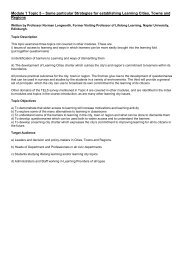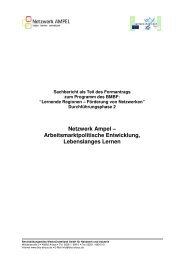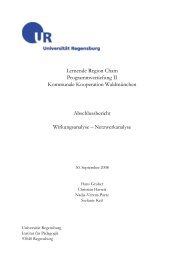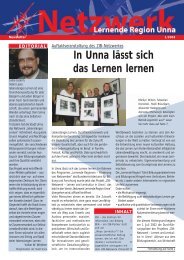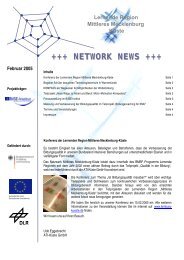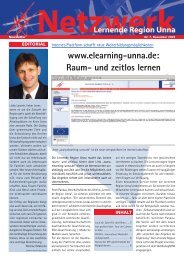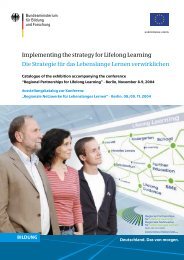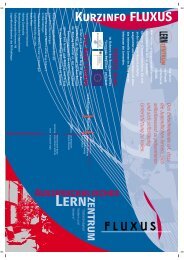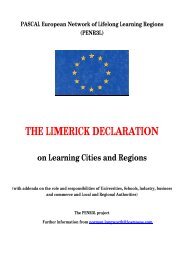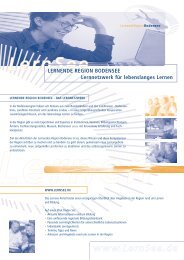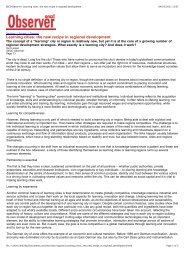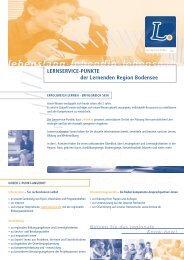SWOT-analysis as a basis for regional strategies - EUROlocal
SWOT-analysis as a basis for regional strategies - EUROlocal
SWOT-analysis as a basis for regional strategies - EUROlocal
You also want an ePaper? Increase the reach of your titles
YUMPU automatically turns print PDFs into web optimized ePapers that Google loves.
employers of the region in question. The public actors may also include, <strong>for</strong> instance,<br />
<strong>regional</strong> or district units of railway or other infr<strong>as</strong>tructure administration with their<br />
own national structures, which may be partly parallel, partly overlapping with those of<br />
the <strong>regional</strong> development administration.<br />
Owing to their economic importance, such organisations should be co-opted, at le<strong>as</strong>t<br />
on the fringes of the RSGs. They may not find a clear role in the programming stage,<br />
and their own operations may be so gigantic that the programme’s entire<br />
implementation scheme would stand <strong>for</strong> a mere fraction of them. Yet this does not<br />
mean that these organisations would not be interested in the in<strong>for</strong>mation produced in<br />
the programming ph<strong>as</strong>e. While their perspectives are inevitably different, particularly<br />
<strong>for</strong> the “non-RSGs” the <strong>SWOT</strong> may constitute a window <strong>for</strong> looking at the way the<br />
strategy makers – actors that they may well meet <strong>as</strong> stakeholders on <strong>for</strong>a dealing with<br />
other issues than those explicitly labelled <strong>regional</strong> development processes – analyse<br />
the terms of the region’s development, both its constraints and particular <strong>as</strong>sets.<br />
This knowledge can actually be very highly valued by actors such <strong>as</strong> the region’s key<br />
employers and value-adding enterprises. However, in order to receive such an<br />
acclaim, the programming document must provide its readers with a skilfully<br />
processed and analytical review of the leading trends in the social development of the<br />
enterprises’ immediate environment. This may also be something the enterprises<br />
might well find worth taking part in <strong>as</strong> a part of their own intermediate/long-range<br />
manpower and investment scenarios. This adds a new customer- or stakeholdercentred<br />
perspective to the elements of a programme. In order to have such an external<br />
relevance its analytical parts must be precise enough so that the entire programme<br />
document actually is given a possibility to encomp<strong>as</strong>s the most elementary and even<br />
<strong>for</strong>eseeable but emergent trends it professes to. Moreover, they have to be logical<br />
enough to <strong>for</strong>m a clear continuum – moving from the description of a region in<br />
question, its p<strong>as</strong>t developments and socio-economic structure to its organisational and<br />
institutional capacities - and facilitate the explication of the vision and a strategy with<br />
due goals and me<strong>as</strong>ures that need to be taken. It could thus be maintained that the<br />
<strong>SWOT</strong> <strong>analysis</strong> is a culmination point in the logical, or even narrative, structure of<br />
the programming document.<br />
This being said, it is possible to define a set of particular “domains” a programming<br />
document may be supposed to consist of. They have particular temporal reference<br />
points with regard to the programming process and follow each other chronologically.<br />
The first stage refers to p<strong>as</strong>t development and is the descriptive <strong>as</strong>sessment of the<br />
region’s trends. The present stage of the document and the entire programming<br />
process can best be read from the <strong>analysis</strong>, which should also link historically<br />
accumulated strengths and weaknesses to opportunities and threats concerning future<br />
developments. Finally, the visions and <strong>strategies</strong> <strong>as</strong> well <strong>as</strong> the goals and me<strong>as</strong>ures<br />
portrayed in the document must be clearly b<strong>as</strong>ed on the future. From the viewpoint of<br />
the <strong>SWOT</strong> <strong>as</strong> the core of the analytical text, the descriptive part represents a backward<br />
linkage, where<strong>as</strong> the visions, <strong>strategies</strong>, goals and me<strong>as</strong>ures represent a <strong>for</strong>ward<br />
linkage. As this terminology indicates, the logical structure of the programming<br />
document is treated here <strong>as</strong> a vertical dimension of which the <strong>analysis</strong> is a part.<br />
33



